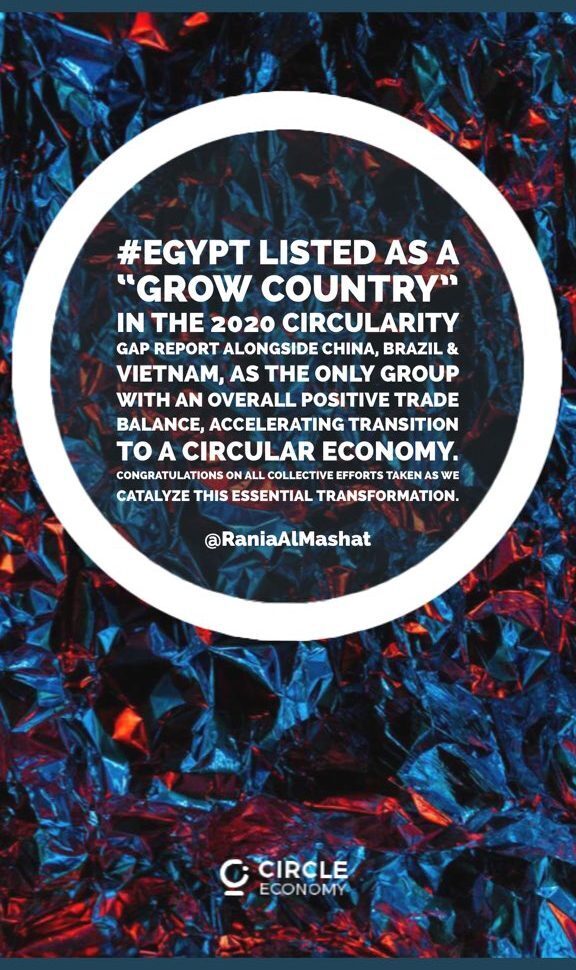
4 countries launch $134 m project to eliminate use of mercury in medical devices
The Governments of Albania, Burkina Faso, India, Montenegro and Uganda have teamed up to launch ...

Egypt was among the six “Grow Countries” listed by the 2020 Circularity Gap Report. The Grow profile was most relevant to countries in Latin America and Northern Africa, as well as those with an economy in transition in Eastern Europe, the Caucasus and Central Asia, plus the larger Asian countries.
The largest countries falling under the Grow profile are China, Indonesia, Brazil, Mexico, Vietnam and Egypt.
Egyptian Minister of International Cooperation Rania el Mashaat said these countries represent “the only group with an overall positive trade balance, accelerating transition to a circular economy.”
The minister said on her Twitter account “Congratulations on all collective efforts taken as we catalyze this essential transformation.”
Mashaat said “In January 2020, I shared with you the ministry’s vision to strengthen engagement aimed at achieving a circular economy. Today, I am proud that Egypt is featured as ‘Grow Country’ in the 2020 Circularity Gap Report.”
Grow countries are, increasingly, the manufacturers of the world and the only group with a positive trade balance overall. The economic growth of their manufacturing industries has far outpaced that in Shift countries over the past decade.
Trade is also a key driver of growth — with comparatively low labor costs and favorable trade conditions (albeit, disputed at times), these countries are manufacturing and processing goods for markets around the world.
Both imports and exports reflect this, whilst being moderated by the relatively low levels of domestic consumption compared to Shift countries.
However, Grow countries have made considerable headway in lifting vast parts of society out of poverty and providing access to essential means.
Grow countries often have a high demographic share of young people, as a result of recent population growth.
The potential of this human capital to contribute to growing welfare necessarily calls for investment in infrastructure and education, as well as effective, sustainable management of the natural asset base in the long run.
Trends in increased consumption cannot simply be attributed to population growth, however, which will only account for a quarter of the rise forecast by 2030.
The remaining three quarters will come from rising wealth per capita, with the rapidly growing middle class being the key driver. The rate of change can be dramatic — for example, disposable income per household in China more than doubled in the last ten years.
Since economic growth remains a primary lever for poverty alleviation in many Grow countries, it is important that this growth is decoupled from primary resource extraction and environmental degradation; and that all citizens benefit. It should be noted, too, that countries in the Grow profile further exhibit the steepest urbanization curves. For instance, Brazil’s urban population has increased from 40% in 1960 to more than 86% in 2018.
As wealth grows, the proportion of domestic extraction of materials tends to go down, due to increases in international trade; whereas the overall mass of material consumption generally goes up. This tradeoff is already happening in Grow countries, who, in anticipation, are joining their Shift counterparts in positioning themselves strategically around access to scarce resources from elsewhere.
Services also make up an increasing part of global consumption, particularly in Grow countries. As income rises, the share of spending on necessities, such as food decreases; spending on services such as restaurants, hotels, recreation, and culture increases. This change in spending can also involve reconsidering historic development pathways with a large impact on resource use and even quality of life.
Waste management and recycling activities that used to be performed by the informal economy are increasingly integrated into a more formal waste management system. Nonetheless, the informal economy is still responsible for a large share of waste collection and processing in the majority of Grow countries.
A major opportunity, therefore, lies in integrating the decentralized steps of the informal sector’s reverse value chain into and alongside the efficiency of centralized processing and recovery of materials.
In many Grow countries, circular economy initiatives have already been launched to design closed-loop value chains, redesign products and processes and use natural resources more sustainably. Often, these are not referred to as ‘circular’ initiatives even if the program is of European origin — as in the case of Switch Asia.
Regulatory measures which discourage the use of toxic materials, or production of items which are difficult to recycle, can be powerful ways to drive a transition and behavioral change top-down. In order to gain momentum and public support to use waste as a resource, however, it is imperative to be transparent in the motivations for certain bans and to carry consumers along through communication and education.
The Governments of Albania, Burkina Faso, India, Montenegro and Uganda have teamed up to launch ...
Paragon Developments has teamed up with Adeer International, PMaestro alongside their German partner, QNTF, to ...
Crédit Agricole Egypt Foundation for Development and Schneider Electric have successfully concluded the Second Phase ...


اترك تعليقا